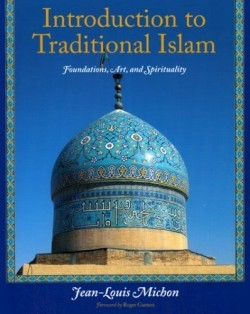Introduction to Traditional Islam
Foundations, Art, and Spirituality
- 2008 INDIES Finalist
- Finalist, Religion (Adult Nonfiction)
Because most introductions to Islam focus their attention on the religion’s history—with particular emphasis on the Prophet Muhammad and the sacred foundation of the Quran—readers seeking a broader examination of Islamic culture in a religious context have been largely disappointed. General audiences too often must either choose an “art book” that neglects the religious bedrock of Islam or pick a work concentrating on the latter but giving short shrift to artistic customs and practices that underlie many Muslim communities.
French scholar Jean-Louis Michon recognizes this gap and fills it capably with Introduction to Traditional Islam: Foundations Art and Spirituality. Using the development of culture in typical Islamic cities as a thread he describes the principles of faith art and architecture music spirituality and mysticism in the world’s second largest religion. In so doing Michon explicitly eschews investigation of “fundamentalist” and “political” Islam which he dismisses as aberrations from the enduring foundations and principles of what he calls “traditional Islam.”
The opening section which covers the tenets of Islam manages to walk the fine line between brevity and adequate treatment of the basic elements of religious practice. Michon covers the Quran the Sunnah (customs of the Prophet Muhammad) and Islamic jurisprudence efficiently before relating the five “pillars” of Islamic belief—expression of faith prayer fasting alms-giving and pilgrimage—and the foundations of the Islamic city in an equally economical fashion. This section of the book like those that follow are liberally illustrated with intriguing full-color images of mosques and city scenes from Islamic locales ranging from Spain to Niger to Uzbekistan (and including most countries in between).
The real comparative advantage of Introduction to Traditional Islam begins in Part II “The Message of Islamic Art.” Here Michon moves beyond mere description to analyze how various art forms—architecture gardens mosaics representational art handcrafts and especially calligraphy—inform and are informed by the context of the Islamic city and Muslims’ spirituality. Standing out in this section is Michon’s correction of the oft-repeated misunderstanding that the Quran bans the human figure in art. He usefully relates that many observers assume such a prohibition when in fact it is traditional Islam’s revulsion at “seeing man substitute himself for the Creator in wishing to imitate natural forms” that explains the rarity of portraits and related representational art in many Islamic cultures.
Michon puts to rest a similar myth in the following section pointing out that although many conservative Islamic communities through the ages have outlawed musical expression neither the Quran nor the Sunnah outlaw the practice. His assessment of Islamic philosophers’ spiritual arguments for and against music is particularly enlightening. The discussion leads to a fascinating overview of instruments rhythms melodies and vocal arts in traditional Islamic societies. He wraps up the book with an extensive analysis of the theory and practice of Sufi mysticism the movement within Islam that incorporates music most fully into its religious rituals.
Introduction to Traditional Islam is at its best when describing the sights and sounds of Islam. Michon—drawing on his experience working in Islamic countries for various United Nations agencies and as a freelance translator/consultant—wisely includes nearly 300 illustrations that bring the text alive and make the book a joy to flip through time and time again. He clearly celebrates the cultural heritage of Islam serving more as a sympathetic observer than a critical appraiser and writing with an enthusiasm that will draw most readers in.
The book is not without shortcomings however. Especially in the early pages the placement of many illustrations is confusing as they do not relate directly to the text and the reader also wonders why Michon introduces scores upon scores of Arabic terms (far too many for a general audience). He also tends to make wide-reaching claims about Islam and Muslims often conflating diverse societal experiences into generalizations that obscure more than they reveal. He acknowledges for example that “the unity of the Muslim community is more than ever compromised by national rivalries and ideological dissensions which rarely have anything to do with the ultimate interests of believers.” But with the exception of lengthy descriptions of various regions’ musical genres he rarely devotes enough attention to the wide differences that characterize contemporary life in much of the Islamic world as much as his idealized vision of the “ traditional Islamic city.”
These points aside Introduction to Traditional Islam stands out among the many introductory works on the Islamic faith for its careful consideration of cultural context and interweaving narratives among Muslim artists architects musicians and religious authorities especially within the urban setting. It will make a rich colorful addition to any display or collection on Islam.
Reviewed by
David Priess
Disclosure: This article is not an endorsement, but a review. The publisher of this book provided free copies of the book to have their book reviewed by a professional reviewer. No fee was paid by the publisher for this review. Foreword Reviews only recommends books that we love. Foreword Magazine, Inc. is disclosing this in accordance with the Federal Trade Commission’s 16 CFR, Part 255.

